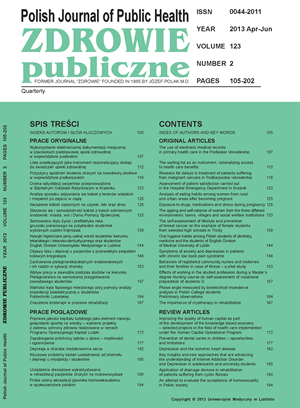Wartości kąta fazowego mierzonego przy pomocy analizy impedancji bioelektrycznej u studentów Politechniki Lubelskiej
DOI:
https://doi.org/10.12923/j.0044-2011/123-2/a.13Słowa kluczowe:
analiza impedancji bioelektrycznej, kąt fazowy, reaktancja, rezystancjaAbstrakt
Wstęp. Kąt fazowy (PA) ustala się na podstawie wartości rezystancji (R) i reaktancji (Xc) mierzonych przy pomocy analizy impedancji bioelektrycznej. Biologiczne znaczenie tego parametru jest niejasne, aczkolwiek coraz częściej wykorzystuje się go do oceny stanu odżywienia.
Cel. Badanie zostało przeprowadzone w celu wykrycia istotnych statystycznie różnic w rezystancji, reaktancji i kącie fazowym w grupie zdrowych kobiet i mężczyzn.
Materiał i metody. Analiza impedancji bioelektrycznej przy użyciu aparatu SFB7 BioImp v1.55 (Pinkeba Qld 4008, Australia) przeprowadzono na grupie 60 studentów Politechniki Lubelskiej (30 kobiet i 30 mężczyzn). Kąt fazowy ustalono bezpośrednio z wartości Xc i R (PA=arcus tangens Xc/R x 180 stopni/π). R i Xc zostały zmierzone przy częstotliwościach 5, 50, 100 i 200 kHz. Do wykrycia istotnych statystycznie różnic między porównywanymi grupami użyto testu t-Studenta dla grup niezależnych. Przyjęto 5% błąd wnioskowania i związany z nim poziom istotności p<0,05.
Wyniki. Przy częstotliwości 50 kHz nie zaobserwowano istotnej różnicy statystycznej w reaktancji pomiędzy grupą mężczyzn i kobiet (odpowiednio 59,63±6,46 ohm vs. 61,54±8,56 ohm; p=0,34). Stwierdzono istotnie statystyczną różnicę w grupie mężczyzn i kobiet w rezystancji (odpowiednio 595,46±62,84 ohm vs. 725,28±74,40 ohm; p<0,000001) i kącie fazowym (odpowiednio 5,75º±0,65 vs. 4,86º±0,53; p<0,000001).
Wnioski. Wartość kąta fazowego różni się w grupie mężczyzn i kobiet. Potwierdzenie istnienia różnic w wartości kąta fazowego w różnych wiekowo grupach zdrowych polskich mężczyzn i kobiet wymagają dalszych badań
Bibliografia
1. Bosy-Westphal A, Danielzik S, Dörhöfer RP, et al. Phase angle from bio¬electrical impedance analysis: population reference values by age, sex, and body mass index. JPEN. 2006;30(4):309-16.
2. Simons JPFHA, Schols AMWJ, Westerterp KR, et al. The use of bio¬electrical impedance analysis to predict total body water in patients with cancer cachexia. Am J Clin Nutr. 1995;61(4):741-5.
3. Zarowitz BJ, Pilla AM. Bioelectrical impedance in clinical practice. DICP. Ann Pharmacother. 1989;23(7-8):548-55.
4. Barbosa-Silva MCG, Barros AJD. Bioelectrical impedance analysis in clinical practice: a new perspective on its use beyond body composi¬tion equations. Curr Opin Clin Nutr Metab Care. 2005;8(3):311-7.
5. Ackmann JJ, Seitz MA. Methods of complex impedance measurements in biologic tissues. Critical Rev Biomed Eng. 1984;11(4):281-311.
6. Schwenk A, Beisenherz A, Römer K, et al. Phase angle from bioelec¬trical impedance analysis remains an independent predictive marker in HIV – infected patients in the era of highly active antiretroviral treat¬ment. Am J Clin Nutr. 2000;72:496-501.
7. Schwenk A, Ward LC, Elia M, Scott GM. Bioelectrical impedance analysis predicts outcome in patients with suspected bacteremia. Infect. 1998;26:277-82.
8. Selberg O, Selberg D. Norms and correlates of bioimpedance phase angle in healthy human subjects, hospitalized patients, and patients with liver cirrhosis. Eur J Appl Physiol. 2002;86:509-16.
9. Maggiore Q, Nigrelli S, Ciccarelli C, et al. Nutritional and prognostic correlates of biompedance indexes in hemodialysis patients. Kidney Int. 1996;50:2103-8.
10. Chertow GM, Johansen KL, Lew N. Vintage, nutritional status, and sur¬vival in hemodialysis patients. Kidney Int. 2000;57:1176-81.
11. Van Lettow M, Kumwenda JJ, Harries AD, et al. Malnutrition and the severity of lung disease in adults with pulmonary tuberculosis in Ma¬lawi. Int J Tuberc Lung Dis. 2004;8:211-7.
12. Toso S, Piccoli A, Gusella M, et al. Bioimpedance vector pattern in can¬cer patients without versus locally advanced or disseminated disease. Nutr. 2003;19:510-4.
13. Barbosa-Silva MCG, Barros AJD, Wang J, et al. Bioelectrical imped¬ance analysis: population reference values for phase angle by age and sex. Am J Clin Nutr. 2005;82(1):49-52.
14. Dittmar M. Reliability and variability of bioimpedance measures in normal adults: effects of age, gender and body mass index. Am J Phys Anthropol. 2003;122(4):361-70.


